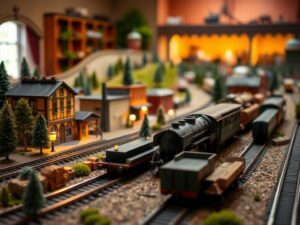Common Mistakes New HO Scale Modelers Make
Common Mistakes New HO Scale Modelers Make
Common Mistakes New HO Scale Modelers Make
Welcome to the wonderful world of model railroading! The thrill of creating your own miniature railway, complete with bustling stations, winding tracks, and rumbling locomotives, is unlike anything else. But like any hobby that demands precision and creativity, it can sometimes be daunting for newcomers. Fear not, fellow rail fans! This guide is designed to help you avoid the pitfalls many HO scale beginners stumble upon, setting you on the path to building a magnificent model railroad.
Before we dive into those common mistakes, let’s clarify why HO scale has captivated generations of modelers. HO (pronounced “Oh-El”) sits in that sweet spot between being detailed and manageable. With its smaller size compared to larger scales, you can achieve impressive detail while keeping your layout relatively compact, fitting it within a room or even on a table.
Let’s Get Rolling: Understanding Scale
The heart of model railroading lies in the concept of scale â the ratio between the size of your model and its real-world counterpart. HO scale, with its 1:87 ratio, translates to about 3.5 inches representing one foot. So a typical diesel locomotive, for example, would stand roughly 7 inches long in HO scale.
Common HO Scale Beginner Mistakes – Avoiding the Pitfalls
- Not Researching Before You Start: Jumping headfirst into any project can be exciting but often leads to missteps. In model railroading, extensive research is crucial before you lay down a single track.
- Plan Your Layout Carefully: Sketch out your dream railway! Determine its size, shape, and features (tracks, scenery, buildings). Online planning tools or even simple graph paper can be helpful. Consider future expansion as well!
- Learn About Different Types of Locomotives & Rolling Stock: Do you prefer vintage steam engines or sleek diesel power? Each type has its quirks and operating requirements. Explore different brands, eras, and aesthetics that excite you.
- Ignoring Track Planning Fundamentals:
Tracks are the lifeblood of your layout. While seemingly straightforward, a well-designed track plan avoids congestion and facilitates smooth train movement:
- Turnouts & Switches: Don’t skimp on quality turnouts! They direct train movements, so investing in reliable mechanisms will prevent derailments and frustrations later.
- Minimal “Spaghetti”: Avoid tangled mess of tracks (“spaghetti”). Embrace curved tracks (not just straight runs) for visual appeal and to manage space efficiently.
-
Underestimating Wiring & Electronics: Electrical systems power your locomotives and signals, adding realism and complexity:
- Track Power Distribution: Use multiple transformers with track boosters if you have a larger layout to avoid voltage drop and keep your trains running smoothly.
- Electrical Standards: Stick to standardized DCC (Digital Command Control) systems for greater control, sound, and automation capabilities. Start simple but plan for expansion!
-
Skipping Wiring Best Practices: Neat wiring makes for easier maintenance and a cleaner look under your layout.
- Use color-coding and clearly labeled connectors for track feeders and power wires.
- Tuck wiring neatly beneath the layout to avoid tangles.
-
Overlooking the Power of Scenery:
A visually stunning layout goes beyond just trains. Scenery transforms your miniature world:
- Landscaping Materials: Experiment with ballasting (crushed stone), grasses, trees, and water effects. Many materials are available at craft stores or specialized hobby shops.
- Depth & Texture: Layer different materials for realism â use foam board, cardboard, and papier-mâché to create hills, valleys, and structures.
-
Rushing the Build Process: Patience is a virtue in model railroading! A carefully planned and executed build results in greater satisfaction and enjoyment.
- Take your time with each stage (track laying, scenery building) â it’s about creating something you’ll be proud of.
- Embrace the learning process: Experiment, make mistakes (everyone does!), and learn from them!
-
Forgetting to Add Detail & Realism: Don’t underestimate the power of small touches! These details elevate your layout:
- Static Vehicles: Miniature cars, trucks, and even pedestrians add a sense of life and activity to your scene.
- Signage: Use printed or custom-made signs for stations, businesses, and roadsides.
HO Scale Beginner Mistakes – A Concluding Look
Remember, fellow modelers, learning is an ongoing journey in the fascinating world of HO scale. The common mistakes discussed above are simply opportunities to learn and refine your skills. Embrace each project with passion, patience, and a healthy dose of research.
Don’t hesitate to join online forums or connect with local model railroad clubs â the shared knowledge and camaraderie can be invaluable. Keep in mind, building your HO scale world is about the process as much as the finished product. Enjoy every step, from planning your layout to seeing your trains come to life!
Now it’s Your Turn:
What other mistakes do you think new model railroaders might make? Share your experiences and insights in the comments below â let’s create a supportive community of passionate hobbyists!




